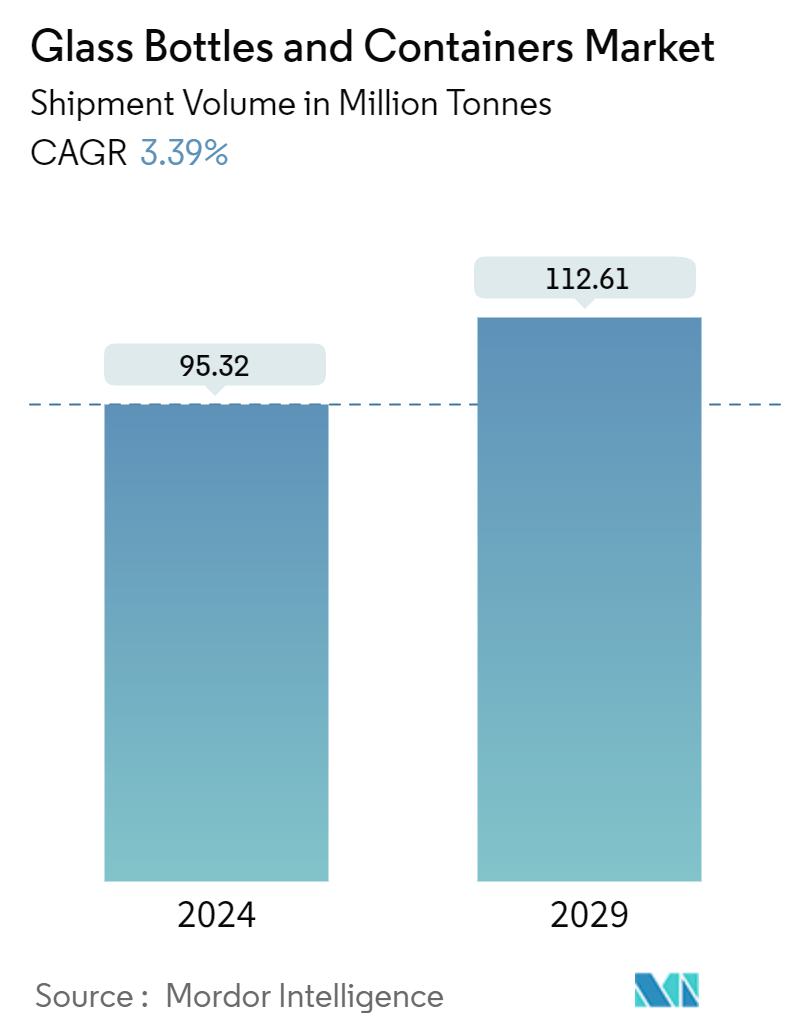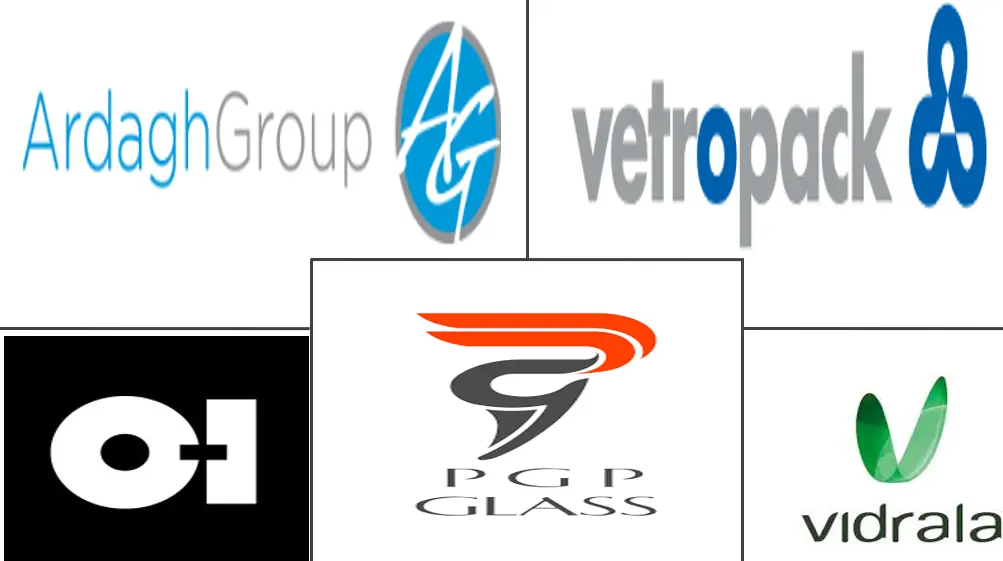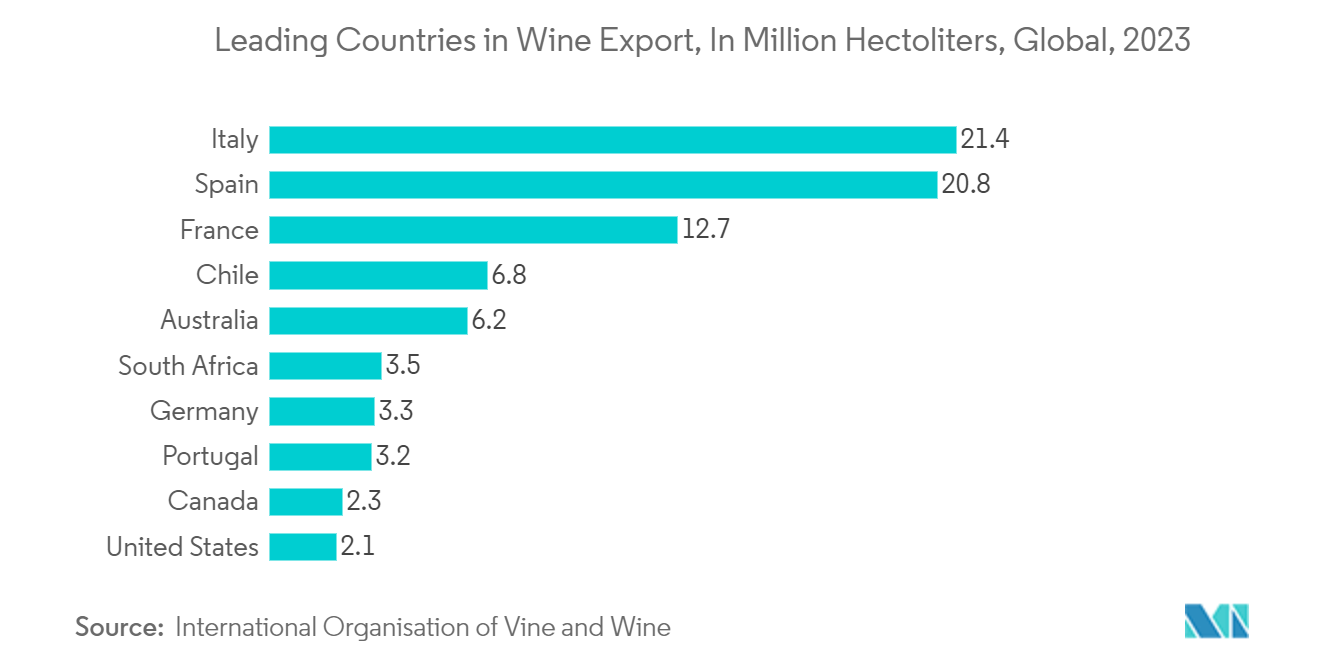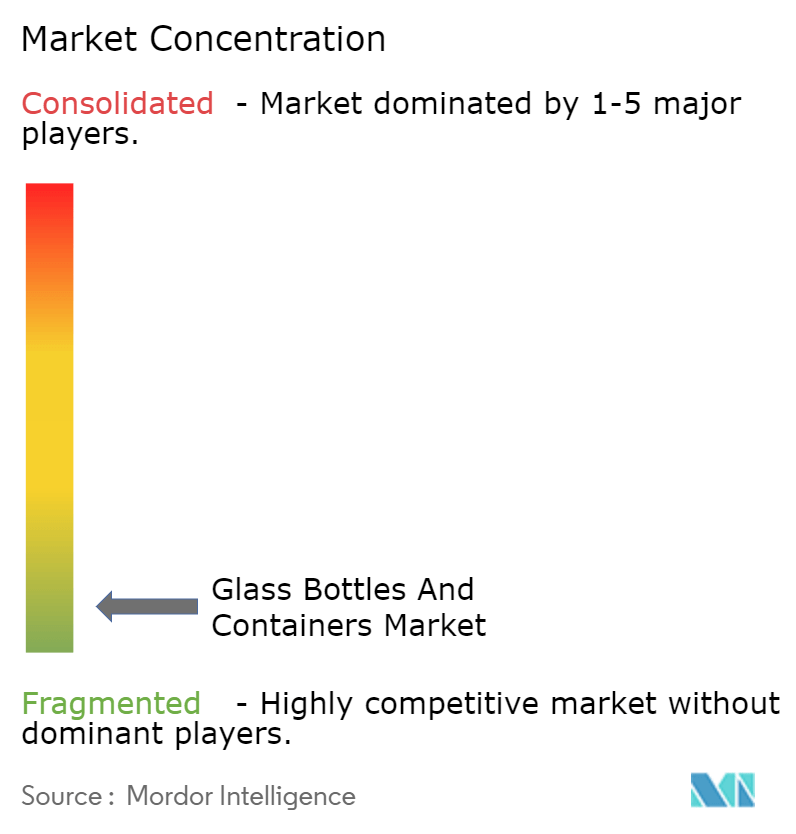Container Glass Market Size

| Study Period | 2019 - 2029 |
| Market Volume (2024) | 95.32 Million tonnes |
| Market Volume (2029) | 112.61 Million tonnes |
| CAGR (2024 - 2029) | 3.39 % |
| Fastest Growing Market | Asia Pacific |
| Largest Market | Europe |
| Market Concentration | Low |
Major Players
*Disclaimer: Major Players sorted in no particular order |
Container Glass Market Analysis
The Glass Bottles And Containers Market size in terms of shipment volume is expected to grow from 95.32 Million tonnes in 2024 to 112.61 Million tonnes by 2029, at a CAGR of 3.39% during the forecast period (2024-2029).
- Growing consumer demand for safer and healthier packaging is fueling the expansion of glass packaging across diverse categories. Cutting-edge technologies, including embossing, shaping, and artistic finishes, are boosting the allure of glass packaging for end users. Furthermore, the rising appetite for eco-friendly products, combined with a thriving food and beverage sector, is driving the container glass market's growth.
- Recently, a significant movement towards transparency in food packaging has emerged. Glass bottles and transparent containers, celebrated for their timeless elegance, resonate strongly with consumers. In light of this trend, companies globally are increasing their production capacities. For example, in February 2024, Arglass, a manufacturer of glass containers, secured over USD 230 million in funding to set up a second furnace at its Georgia campus in the U.S. This facility, slated to commence operations in Q2 2025, is projected to churn out over 350 million sustainable glass containers each year.
- Prominent players in the glass packaging sector encompass Owens-Illinois, Veralia, Ardagh Glass, Vidrala, BA Vidro, and Gerresheimer, among others. These leading manufacturers hold a significant stake in the global market, thanks to their vast production capacities spread across the globe. As a case in point, Ardagh Group, a key global player in sustainable and infinitely recyclable glass packaging, boasts 61 production facilities in 16 countries and is actively broadening its presence in the glass packaging landscape.
- Yet, glass packaging isn't without its hurdles. The inherent fragility of glass bottles and containers demands careful handling throughout operations and logistics. This delicacy complicates transportation, requiring specialized care. Shipping firms are compelled to adopt specific packaging and shipping techniques to guarantee the safe delivery of glass items. Additionally, the carbon footprint linked to glass manufacturing presents another hurdle to the market's expansion.
- Nonetheless, a surge in awareness regarding sustainable packaging, especially in the wake of the pandemic, hints at significant growth prospects in this sector. Emphasizing this momentum, Verallia, the globe's third-largest producer of glass packaging for food and beverages, rolled out an ambitious strategy in May 2024 to curtail CO2 emissions. The firm is eyeing a 46% cut in direct CO2 emissions by 2030 (compared to 2019 benchmarks) and is setting its sights on achieving carbon neutrality by 2050.
Container Glass Market Trends
Wine and Spirits to Lead Beverages Segment
- Coloured glass bottles dominate beverage packaging, primarily to shield wine from sunlight and spoilage. As wine consumption rises, so does the demand for glass packaging. Global market conditions are favouring the glass container industry. With an uptick in both alcoholic and non-alcoholic beverage consumption anticipated over the next couple of years, demand, especially in the beer and alcoholic sectors, is poised to rise.
- Brands and packaging manufacturers are focusing on creating lightweight glass bottles to reduce carbon footprints. There's also a push to design these lightweight bottles for sparkling wines, including champagne. In 2023, French glassmaker Verallia Group, in partnership with Champagne Telmont, trialed an 800-gram champagne glass bottle. These lighter bottles could cut carbon dioxide emissions by about 4% for each bottle produced.
- Glass bottles enhance the wine experience, boasting premium designs and an elegant touch that nods to tradition. This distinct design lends a luxurious feel, distinguishing it from other packaging types. In many developed nations, wine is a popular gift for special occasions, reinforcing the preference for unique glass packaging.
- Data from the International Organization of Vine and Wine indicates a global wine production dip in 2023, with 237.3 million hectoliters produced. In the competitive wine export arena, Italy outpaced Spain in 2023, exporting 21.4 million hectoliters, with France trailing at 12.7 million. This trend highlights Italy's significant demand for beverage container glass.
- Moreover, a report from the National Association of English and Welsh Wine, and Wines of Great Britain (WineGB), indicates a notable rise in on-trade sales for English and Welsh wines. The Anglia Wine Trade Association (Analysis) report predicts English wine production will reach 25-29 million bottles by 2032. This production boost aligns with an expansion of the planted area from 4,000 hectares to an anticipated 7,600 hectares. Such growth is set to drive up the demand for glass bottles and containers. To engage consumers, wine producers are increasingly adopting innovative packaging, unveiling new concepts and designs.

Asia-Pacific is Expected To Witness Robust Growth
- The demand for pharmaceutical container glass packaging in the Asia-Pacific region is on a rapid ascent. This growth is fueled by an expanding healthcare infrastructure, a rising appetite for specialty pharmaceuticals, and vigorous pharmaceutical manufacturing activities. Nations such as China, India, Japan, South Korea, and Australia are witnessing a robust expansion in their pharmaceutical sectors, consequently amplifying the demand for glass container packaging solutions.
- In China, a significant concentration of glass bottle factories—approximately 80%—is found in six key provinces: Shandong, Jiangsu, Henan, Hebei, Zhejiang, and Guangdong. These provinces not only have abundant raw material reserves but also benefit from efficient transportation networks. Additionally, local governments actively support the container glass industry, providing tax incentives and crucial resources like industrial water and electricity. Each production base in these provinces, influenced by the region's advantageous industries, specializes in unique product categories and characteristics.
- China, recognized as the world's foremost exporter of glasses and glassware, sees its products utilized on a global scale. Concurrently, both China and India, significant players in the beverage and pharmaceutical sectors, are experiencing a rapid surge in drug production and consumption. As highlighted in a July 2024 report by World's Top Exports (WTEx), China clinched the title of the world's leading exporter of glass and glassware in 2023, with exports nearing an impressive USD 26 billion—accounting for over 25% of the global market share for that year.
- Japan has a strong inclination towards glass packaging. The country predominantly produces liquor bottles, food and condiment containers, and medicine bottles. Following a government-initiated law in April 2022 aimed at reducing disposable plastic usage, Japan has seen a notable uptick in the demand for sustainable container glass packaging materials.
- Asian manufacturers, echoing the trends set by their European counterparts, have embraced lightweight container glass production technologies. At the forefront of this movement, Japanese manufacturers have taken the lead in pioneering lightweight glass production. Meanwhile, India has emerged as one of Asia's dominant players in container glass production. Prominent Indian manufacturers, such as Hindusthan National Glass and Industries (HNGL), AGI Glaspac, and PGP Glass (formerly Piramal Glass), are making strides with substantial technological investments aimed at producing lightweight glass containers.

Container Glass Market Landscape
The global container glass market is fragmented with a presence of a large number of key players. The market is primarily dominated by a handful of major companies, including Gerresheimer AG, Owens-Illinois (O-I), Ardagh Packaging Group PLC, and Piramal Glass Ltd. These industry leaders operate across various regions and maintain diversified product portfolios. Nevertheless, the industry faces fierce competition, as numerous other companies also manufacture similar products.
Container Glass Market Leaders
-
O-I Glass, Inc.
-
Ardagh Group S.A.
-
Vetropack Holding SA
-
PGP Glass Private Limited
-
Vidrala SA
*Disclaimer: Major Players sorted in no particular order

Container Glass Market News
- September 2024: Ardagh Glass Packaging-North America, a division of Ardagh Group, has unveiled a new line of craft beverage bottles, expanding its portfolio of American-made offerings. These 12-ounce glass bottles, crafted in the United States, come in three vibrant colors: emerald green, flint (clear), and amber (brown). Available for direct purchase from AGP-North America, these bottles are produced using high-quality, 100% recyclable glass. Notably, the glass can be recycled endlessly without any degradation in purity or quality, as emphasized by the company.
- February 2024: O-I Glass has debuted its inaugural eco-designed 75 cl bottle tailored for the wine industry. This bottle's carbon footprint and its journey towards carbon neutrality have received validation from the Carbon Trust, a renowned climate consultancy. Weighing in at 390g and crafted using 82% recycled glass, the Estampe bottle boasts a carbon footprint of 249g of CO2 equivalent. This marks a 25% reduction in carbon emissions when juxtaposed with traditional 500g bottles. Furthermore, its sleek and contemporary design has garnered an impressive 84% purchasing intent among consumers.
Glass Bottle and Container Market Report - Table of Contents
1. INTRODUCTION
1.1 Study Assumptions and Market Definition
1.2 Scope of the Study
2. RESEARCH METHODOLOGY
3. EXECUTIVE SUMMARY
4. MARKET INSIGHTS
4.1 Market Overview
4.2 Export-Import Data of Container Glass
4.3 Industry Standard and Regulation For Container Glass Use For Packaging
4.4 Raw Material Analysis and Material Consideration For Packaging
4.5 Sustainability Trends For Glass Packaging
4.6 Container Glass Furnace and Location
5. MARKET DYNAMICS
5.1 Market Drivers
5.1.1 Growing Demand from Food and Beverage Industry
5.1.2 Sustainability and Recyclability Initiatives Are Expanding End-Users Demand For Glass Packaging
5.2 Market Restraints
5.2.1 High Carbon Footprint due to Glass Manufacturing
5.2.2 Operation and Logistical Concerns
5.3 Trade Scenario - Analysis of the Historical and Current Export-Import Paradigm For Container Glass Industry
6. MARKET SEGMENTATION
6.1 By End-user Vertical
6.1.1 Bevarages
6.1.1.1 Alcoholic (Qualitative Analysis to be Provided)
6.1.1.1.1 Beer and Cider
6.1.1.1.2 Wine and Spirits
6.1.1.1.3 Other Alcoholic Beverages
6.1.1.2 Non-Alcoholic (Qualitative Analysis to be Provided)
6.1.1.2.1 Carbonated Soft Drinks
6.1.1.2.2 Milk
6.1.1.2.3 Water and Other Non-alcoholic Beverages
6.1.2 Food
6.1.3 Cosmetics
6.1.4 Pharmaceutical (Excluding Vials and Ampoules)
6.1.5 Other End-user Verticals
6.2 By Geography*
6.2.1 North America
6.2.1.1 United States
6.2.1.2 Canada
6.2.2 Europe
6.2.2.1 France
6.2.2.2 Germany
6.2.2.3 Italy
6.2.2.4 United Kingdom
6.2.2.5 Spain
6.2.2.6 Poland
6.2.2.7 Russia
6.2.2.8 Denmark
6.2.2.9 Sweden
6.2.2.10 Belgium
6.2.2.11 Czech Republic
6.2.2.12 Netherlands
6.2.2.13 Ukraine
6.2.2.14 Austria
6.2.2.15 Hungary
6.2.3 Asia
6.2.3.1 China
6.2.3.2 India
6.2.3.3 Japan
6.2.3.4 Thailand
6.2.3.5 Australia and New Zealand
6.2.3.6 South Korea
6.2.3.7 Indonesia
6.2.3.8 Vietnam
6.2.4 Middle East and Africa
6.2.4.1 United Arab Emirates
6.2.4.2 Saudi Arabia
6.2.4.3 Egypt
6.2.4.4 Kuwait
6.2.4.5 South Africa
6.2.4.6 Nigeria
6.2.4.7 Morocco
6.2.5 Latin America
6.2.5.1 Brazil
6.2.5.2 Mexico
6.2.5.3 Colombia
6.2.5.4 Chile
6.2.5.5 Argentina
6.2.5.6 Uruguay
6.2.5.7 Ecuador
7. COMPETITIVE LANDSCAPE
7.1 Company Profiles
7.1.1 O-I Glass, Inc.
7.1.2 Vidrala SA
7.1.3 Ardagh Group S.A.
7.1.4 Vetropack Holding SA
7.1.5 PGP Glass Private Limited
7.1.6 Verallia SA
7.1.7 Wiegand-glas GmbH
7.1.8 Stoelzle Oberglas GmbH
7.1.9 Gaasch Packaging
7.1.10 Beatson Clark
7.1.11 Vitro SAB de CV
7.1.12 Schott AG
7.1.13 Glassworks International Limited
7.1.14 Gerresheimer AG
7.1.15 Middle East Glass Manufacturing Co.
7.1.16 Berlin Packaging LLC
7.1.17 BA Glass Group
7.1.18 Verescence France SASU
7.1.19 SGD S.A.
7.1.20 Saverglass Group
- *List Not Exhaustive
8. REGION WISE ANALYSIS OF MAJOR FURNACE SUPPLIER TO THE CONTAINER GLASS PLANTS (North America, Asia-Pacific, Europe, Middle East and Africa and Latin America)
9. FUTURE OUTLOOK OF THE MARKET
Container Glass Industry Segmentation
Glass containers market tracks the demand of glass packaging containers and bottles across the end-users industries including beverage, food, pharmaceutical, cosmetics and others. Glass containers are majorly used in the alcoholic and non-alcoholic beverage industry due to their ability to maintain chemical inertness and sterility and non-permeability.
The Container Glass market is segmented by end-user vertical (beverages [alcoholic (beer and cider, wine & spirits, and other alcoholic beverages] and non-alcoholic [carbonated soft drinks, milk, and water and other non-alcoholic beverages]), food, cosmetics, pharmaceutical, and other end-user verticals) and by geography (North America [United States and Canada], Europe [France, Germany, Italy, United Kingdom, Spain, Poland, Russia, Nordic and Rest of Europe], Asia-Pacific [China, India, Japan, Thailand, New Zealand and Australia, South Korea, Indonesia, Vietnam, and Rest of Asia -Pacific], Middle East and Africa [United Arab Emirates, Saudi Arabia, Egypt, Kuwait, South Africa, Nigeria, Morocco, and Rest of Middle East and Africa] and Latin America [Brazil, Mexico, Colombia, Chile, Argentina, and Rest of Latin America]). The market sizes and forecasts are provided in terms of consumption volume (tonnes) for all the above segments.
| By End-user Vertical | ||||||||||||
| ||||||||||||
| Food | ||||||||||||
| Cosmetics | ||||||||||||
| Pharmaceutical (Excluding Vials and Ampoules) | ||||||||||||
| Other End-user Verticals |
| By Geography* | |||||||||||||||||
| |||||||||||||||||
| |||||||||||||||||
| |||||||||||||||||
| |||||||||||||||||
|
Glass Bottle and Container Market Research FAQs
How big is the Glass Bottles And Containers Market?
The Glass Bottles And Containers Market size is expected to reach 95.32 million tonnes in 2024 and grow at a CAGR of 3.39% to reach 112.61 million tonnes by 2029.
What is the current Glass Bottles And Containers Market size?
In 2024, the Glass Bottles And Containers Market size is expected to reach 95.32 million tonnes.
Who are the key players in Glass Bottles And Containers Market?
O-I Glass, Inc., Ardagh Group S.A., Vetropack Holding SA, PGP Glass Private Limited and Vidrala SA are the major companies operating in the Glass Bottles And Containers Market.
Which is the fastest growing region in Glass Bottles And Containers Market?
Asia Pacific is estimated to grow at the highest CAGR over the forecast period (2024-2029).
Which region has the biggest share in Glass Bottles And Containers Market?
In 2024, the Europe accounts for the largest market share in Glass Bottles And Containers Market.
What years does this Glass Bottles And Containers Market cover, and what was the market size in 2023?
In 2023, the Glass Bottles And Containers Market size was estimated at 92.09 million tonnes. The report covers the Glass Bottles And Containers Market historical market size for years: 2019, 2020, 2021, 2022 and 2023. The report also forecasts the Glass Bottles And Containers Market size for years: 2024, 2025, 2026, 2027, 2028 and 2029.
Glass Bottle and Container Industry Report
Statistics for the 2024 Glass Bottles And Containers market share, size and revenue growth rate, created by ����vlog��ý™ Industry Reports. Glass Bottles And Containers analysis includes a market forecast outlook for 2024 to 2029 and historical overview. Get a sample of this industry analysis as a free report PDF download.



